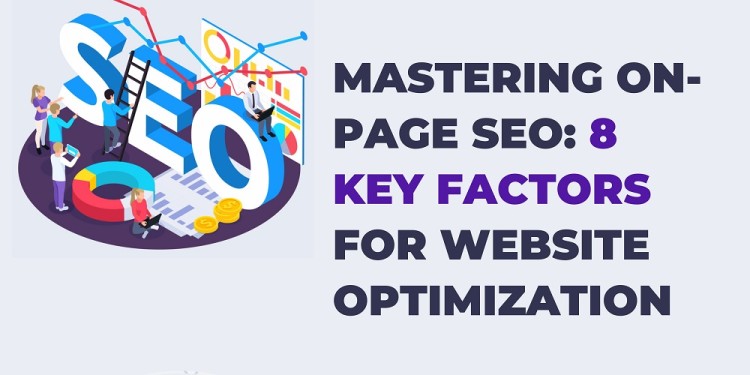
Website optimization is essential for improving search engine rankings and attracting organic traffic. One crucial aspect of optimization is mastering on-page SEO. By strategically focusing on key factors, you can enhance your website’s visibility and provide a better user experience. In this article, we will delve into eight essential on-page SEO factors that play a significant role in optimizing websites.
What is SEO?
Search Engine Optimization (SEO) refers to the practice of optimizing web pages to improve their visibility and organic (non-paid) search engine rankings. By optimizing various on-page and off-page elements, SEO aims to make your website more accessible and attractive to search engines, ultimately driving more targeted traffic to your site.
Different Types of SEO
SEO can be broadly categorized into three main types: on-page SEO, off-page SEO, and technical SEO. Let’s explore these types in a tabular format with examples:
| Type | Description | Example |
| On-Page SEO | Optimization of on-page elements of a web page such as content, meta tags, URLs, and headers | Keyword optimization, headers, images, title tags, etc. |
| Off-Page SEO | Optimization activities performed outside the page to improve its authority and popularity | Backlink building, Local SEO, Social Media, Public Relations, etc. |
| Technical SEO | Optimization of technical aspects to improve website performance and indexability | XML sitemap creation |
High-Quality Content
High-quality content refers to well-written, informative, and engaging content that meets the needs and interests of your target audience. It should provide value and answer their queries. When creating content, consider the following:
- Keyword Optimization: Conduct keyword research to identify relevant keywords and incorporate them naturally into your content. This helps search engines understand the topic and context of your page.
- Readability: Ensure your content is easy to read by using short paragraphs, subheadings, bullet points, and relevant visuals. This improves user experience and encourages visitors to spend more time on your site.
- User Intent: Understand the intent behind the search queries related to your content. Provide comprehensive answers or solutions to address user needs effectively.
URLs
URL optimization involves creating search engine-friendly URLs that are concise, descriptive, and contain relevant keywords. Consider the following tips:
- Keep it concise: Use short URLs that accurately describe the content of the page.
- Use hyphens: Separate words in the URL with hyphens (-) instead of underscores (_) to improve readability.
- Avoid unnecessary characters: Eliminate special characters, symbols, or numbers that don’t add value to the URL.
Internal Linking
Internal linking refers to the practice of linking relevant pages within your website. It helps search engines discover and navigate your site more effectively. Consider these guidelines:
- Relevant Anchor Text: Use descriptive anchor text that clearly indicates the destination page and contains relevant keywords.
- Balanced Linking: Link to related content naturally, without overloading pages with excessive links.
- Hierarchical Structure: Implement a hierarchical structure with categories and subcategories to organize your content and establish a logical linking structure.
Schema Markup
Schema markup is structured data that you add to your web pages to provide additional information to search engines. It helps search engines understand your content better and can result in enhanced search results, known as rich snippets. Some common types of schema markup include product information, reviews, ratings, recipes, and events.
Page Speed
Page speed refers to the time it takes for your web page to load. It is crucial for user experience and search engine rankings. Consider these optimization techniques:
- Image Optimization: Compress and resize images without compromising quality to reduce their file size.
- Code Minification: Minify CSS, JavaScript, and HTML code by removing unnecessary spaces, comments, and line breaks.
- Caching: Implement browser caching to store static files on the user’s device, reducing server load and improving load times for returning visitors.
Keywords
Keyword optimization involves identifying and strategically incorporating relevant keywords into your content, meta tags, headings, and URLs. Tips for effective keyword usage include:
- Keyword Research: Use tools like Google Keyword Planner or other keyword research tools to find high-ranking and relevant keywords related to your content.
- Natural Integration: Incorporate keywords naturally into your content, avoiding keyword stuffing (excessive and irrelevant keyword usage).
- Long-Tail Keywords: Consider targeting long-tail keywords, which are more specific and often have less competition.
Header Tags
Header tags (H1, H2, H3, etc.) are HTML tags used to structure your content. They help search engines understand the hierarchy and importance of different sections within your page. Tips for header tag optimization include:
- H1 Tag: Use the H1 tag for the main title of your page, incorporating relevant keywords.
- Subheadings: Use H2, H3, and subsequent tags for subheadings within your content, organizing it into logical sections.
Meta Title and Descriptions
Meta titles and descriptions are HTML tags that provide concise summaries of your web page’s content in search engine results. They influence click-through rates and should be enticing and relevant. Consider the following guidelines:
- Meta Title: Craft a unique, concise, and descriptive title that accurately represents your page’s content and includes relevant keywords.
- Meta Description: Write a compelling and concise description that provides an overview of your page’s content, entices users to click, and includes relevant keywords.
Final Words
Mastering on-page SEO is essential for optimizing your website and improving its visibility in search engine results. By focusing on the above discussed factors you can significantly enhance your website’s on-page optimization. But also remember to keep up with the latest SEO trends and regularly analyze your website’s performance to stay ahead in the competitive online landscape.
Author Bio:
Karan Sharma is the co-founder & CEO of Kinex Media Inc. He intends to bring a massive transformation in eCommerce web designing & development. His team of talented IT professionals knows the secret of getting huge conversions.
